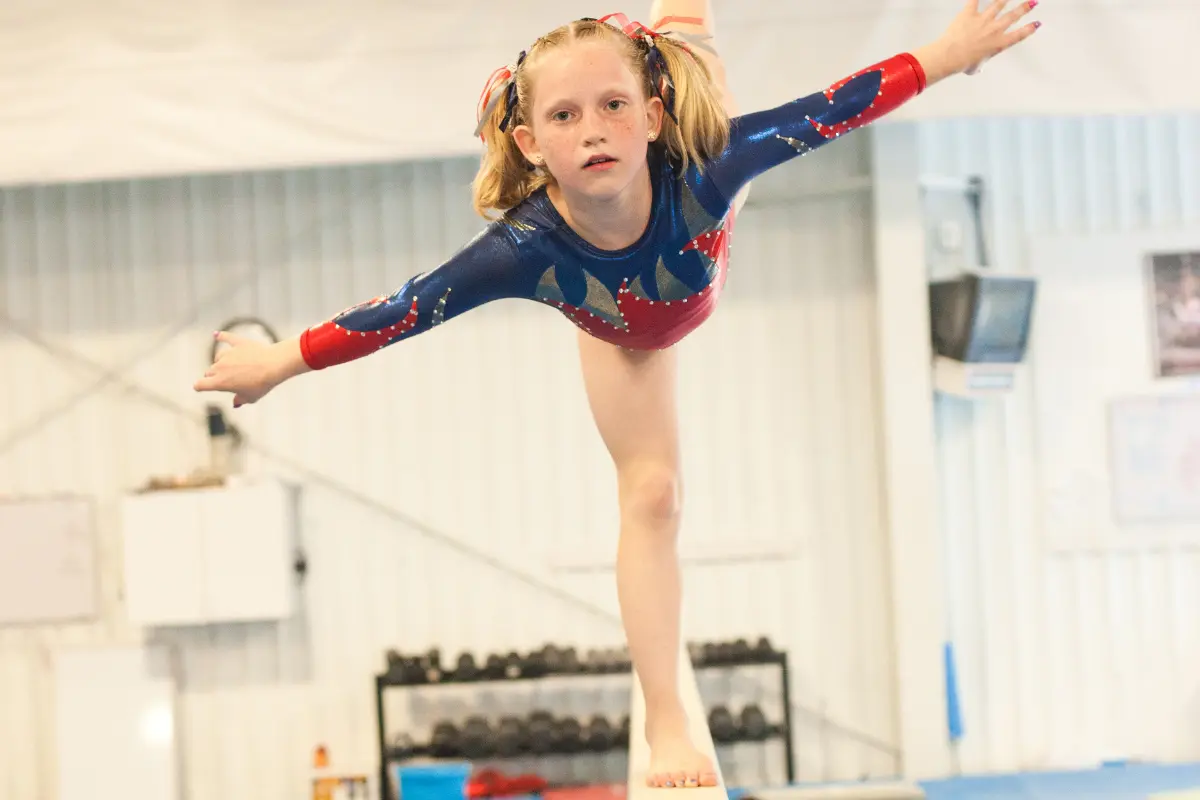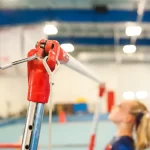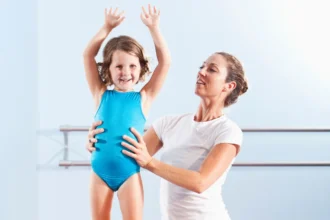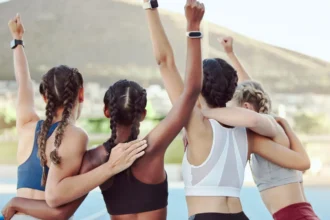The Xcel Program is one of the most popular options in USA Gymnastics because it offers flexibility, creativity, and accessibility for gymnasts of all ages and skill levels.
Unlike the Development Program (Levels 1–10), which follows strict compulsory routines and mobility rules, Xcel allows gymnasts to design unique routines and progress at a pace that fits their goals.
What Is the Xcel Program?
The Xcel Program was created to give gymnasts a less rigid and more customizable path in competitive gymnastics. It is designed to:
- Provide competitive opportunities without requiring the high time and financial commitment of the Development Program.
- Allow gymnasts to create personalized routines that highlight their strengths.
- Offer a pathway for multi-sport athletes, late starters, or recreational gymnasts who want competition without the full intensity of Level 10 or Elite.
Xcel is also popular with gyms because it opens the door to more inclusive competition opportunities, especially for athletes who might not thrive in a traditional track but still want to perform on the big stage.
How the Xcel Divisions Work
Xcel has six divisions, each with its own minimum age, entry rules, and mobility requirements. Athletes generally move up through the divisions as their skills, consistency, and confidence grow.
| Division | Minimum Age | Entry & Mobility Rules | Best For |
|---|---|---|---|
| Bronze | 5 | No prerequisite | Very young or brand-new gymnasts |
| Silver | 6 | No prerequisite | Beginners ready for their first meets |
| Gold | 7 | No prerequisite | Athletes building strength and basics |
| Platinum | 8 | 32.00 AA at Gold or 8.5 IES | Mid-level competitors |
| Diamond | 9 | 32.00 AA at Platinum or 8.5 IES | Experienced gymnasts close to DP L7–9 |
| Sapphire | 12 | 32.00 AA at Diamond or 8.5 IES (or petition with video) | Teen gymnasts, late starters, or college-prep flexibility |
*IES = Individual Event Specialist route, which allows gymnasts to move up divisions by earning strong scores on a single event (usually 8.5 or higher).
What Makes Xcel Different from the Development Program?
The Development Program (DP) and Xcel Program are both part of USA Gymnastics but serve different purposes:
- DP Levels 1–10: Routines are strict (Levels 1–5 are compulsory), and mobility depends on meeting exact All-Around scores. This track is best for gymnasts aiming for collegiate or elite competition.
- Xcel Divisions: Routines are custom from the very start, with looser rules about which elements must appear. This track is best for gymnasts seeking flexibility, creativity, or balance with other activities.
The two programs are separate: Xcel scores cannot be used to qualify into the Development Program. If an athlete switches from Xcel to DP, her coach places her in the level that matches her skills, then she follows the DP mobility chart moving forward.
Inside the Divisions (Bronze → Sapphire)
Let’s take a closer look at each Xcel division and what you can expect:
Bronze
- Age: Minimum 5 years old
- Focus: Very beginning skills such as forward rolls, handstands, cartwheels, and basic bar swings.
- Routine Style: Simple choreography with short routines, no advanced connections.
- Best For: Young gymnasts just starting, or those testing competition for the first time.
Silver
- Age: Minimum 6 years old
- Focus: Refining cartwheels, handstands, walkovers, and introducing vault and beam dismounts.
- Routine Style: Still basic but slightly longer and more polished.
- Best For: Beginners with a little more confidence who want a first taste of real meets.
Gold
- Age: Minimum 7 years old
- Focus: More demanding skills like back walkovers, squat-ons to high bar, and stronger vaults.
- Routine Style: Routines require more elements and smoother transitions.
- Best For: Gymnasts building strength and moving toward intermediate-level competition.
Platinum
- Age: Minimum 8 years old
- Entry: Must score 32.00 AA at Gold or 8.5 IES.
- Focus: Skills begin to resemble lower optional DP levels (Level 6–7 range), including flight elements and connected tumbling.
- Routine Style: More choreography required, with variety in dance, jumps, and tumbling.
- Best For: Gymnasts who want serious competition but not the strictness of DP.
Diamond
- Age: Minimum 9 years old
- Entry: Must score 32.00 AA at Platinum or 8.5 IES.
- Focus: High-level gymnastics, with tumbling, pirouettes, releases, and strong artistry.
- Routine Style: Comparable to DP Level 7–9 routines.
- Best For: Advanced gymnasts preparing for college-recruiting exposure or those who want to showcase strong skills without committing to DP Nationals.
Sapphire
- Age: Minimum 12 years old
- Entry: Must score 32.00 AA at Diamond or 8.5 IES. Petition options exist for late bloomers or injured gymnasts with video evidence.
- Focus: Sapphire is the highest Xcel division, introduced in 2023. Routines often rival Level 9–10 skills, including double saltos, pirouettes, and difficult beam acro.
- Routine Style: Designed to showcase athletes at their peak without requiring the exactness of DP.
- Best For: Teen gymnasts, late starters, or athletes eyeing college gymnastics who need flexibility in training hours and routine composition.
Competitions & Championships
Each state and region sets its own qualifying scores for Xcel State and Regional Championships. While the Development Program has Easterns, Westerns, and Nationals, Xcel’s highest level of competition is usually Regionals. Some states also host Xcel-only invitationals, giving gymnasts additional opportunities to compete in a more relaxed environment.
Why Choose Xcel?
Parents and athletes often ask, “Why Xcel instead of DP?” Here are the main reasons families choose this path:
- Flexibility: Gymnasts can balance other sports, academics, and activities.
- Creativity: Custom routines let athletes showcase their favorite skills and personality.
- Inclusion: Welcomes athletes of all ages—even those who start gymnastics later.
- Lower Commitment: Fewer training hours and lower costs than DP.
- Longevity: Keeps more athletes involved in gymnastics who might otherwise quit due to time or pressure.
FAQs About Xcel Gymnastics
Can my child switch from DP to Xcel?
Yes. Athletes can move between programs with their coach’s guidance, though DP scores don’t “transfer” to Xcel and vice versa.
Does Xcel lead to Elite gymnastics?
No. Xcel is not a pathway to Elite. Athletes interested in Elite must compete in the Development Program (Level 10 → Hopes → Elite).
Can Xcel gymnasts compete in college?
Yes, though it’s less common. Most NCAA gymnasts come from DP Level 10, but strong Sapphire or Diamond gymnasts can catch recruiters’ attention, especially if their routines show NCAA-ready skills.
Is Xcel easier than DP?
It depends. Lower divisions are easier than compulsory DP levels, but Diamond and Sapphire can rival DP Levels 7–10 in skill demand.
Bottom Line
The Xcel Program is about making gymnastics accessible and fun while still competitive. From Bronze’s simple rolls to Sapphire’s high-level tumbling, the program creates a pathway for athletes who want to enjoy gymnastics on their own terms, without the strict, time-intensive demands of the Development Program.












